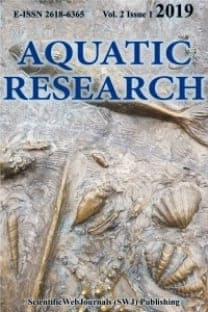Species composition, substrate specificity, and seasonal abundance of periphytic algae in a tropical riverine systemPeriyar, India
___
Albay, M., Akcaalan, R. (2008). Effects of water quality and hydrologic drivers on periphyton colonization on Sparganium erectum in two Turkish lakes with different mixing regimes. Environmental Monitoring and Assessment, 146, 171- 181. https://doi.org/10.1007/s10661-007-0069-5Adhikary, S.P., Das, S. K. (2012). Freshwater Algae of Eastern India. Daya Publishing House.
Ansari, E., Gadhia, M., Ujjania, N.C. (2015). Phytoplankton diversity and water quality assessment of ONGC pond, Hazira. International Journal of Research in Environmental Science, 1(1), 1-15.
APHA. (21st Ed.). (2005). Standard methods for the examination of water and wastewater. American Public Health Association. ISBN: 0875530478
Biggs, B.J.F. (1996). Patterns in benthic algae of streams. Algal Ecology: freshwater benthic ecosystems. Academic Press. ISBN: 9780126684506 https://doi.org/10.1016/B978-012668450-6/50031-X
Biggs, B.J.F, Kilroy, C. (2000). Stream periphyton monitoring manual. The New Zealand Ministry for the Environment, NIWA. ISBN: 0-478-09099-4
Cetto, J.M., Felisberto, A.S., Leandrini, J.A., Rodrigues, L. (2004). Periphyton algae community in Irai reservoir, Paraná state, Brazil. Acta Scientiarum. Biological Sciences, 26, 1-7. https://doi.org/10.4025/actascibiolsci.v32i1.3764
De Souza, M.L., Ferragt, C., Pellegrini, B.G. (2015). Periphytic algal community structure in relation to seasonal variation and macrophyte richness in a shallow tropical reservoir. Hydrobiologia, 755, 183-196. https://doi.org/10.1007/s10750-015-2232-2
Dhanasekaran, M., Bhavan, S.P., Manickam, N., Kalpana, R. (2016). Physico-chemical characteristics and zooplankton diversity in a perennial lake at Dharmapuri. Journal of Entomology and Zoology Studies, 5(10), 285-292.
Edmondson, W.T. (2nd Ed.). (1959). Freshwater Biology. John Wiley and Sons Inc. ISBN: 978-04-71232988
Franca, R.C.S., Lopes, M.R.M., Ferragut, C. (2011). Structural and successional variability of periphytic algal community in a Amazonian lake during the dry and rainy season. Acta Amazonica, 4(2), 257-266. http://dx.doi.org/10.1590/S0044-59672011000200010
Gurumayum, S.D., Goswami, U.C. (2013). Studies on seasonal and topographical variations of periphyton in the rivers of Manipur. Journal of Environmental Biology, 34, 599-604.
Hajong, P., Ramanujam, P. (2018). Seasonal variation in algal diversity and productivity in Dachilake, Meghalaya. Journal of Algal Biomass Utilization, 9(2), 9-24.
John, J., Francis, M. S. (2012). An Illustrated Algal Flora of Kerala, Vol. 1, Idukki District. GCS Books. ISBN: 978- 9385657054
Joseph, J. (2017). Diversity and distribution of phytoplankton in an artificial pond. International Journal of Advance Research in Biological Sciences, 4(5). http://dx.doi.org/10.22192/ijarbs.2017.04.05.013
Joseph, M.L. (2004). Status report on Periyar river: The declining trend of biodiversity and fish production in consequence of pollution in the lower reaches of Periyar river. Report of the Kerala Research Programme for Local Level Development. Thiruvananthapuram: Centre for Development Studies.
Kanavillil, N., Kurisseryl, S. (2013). Temporal variation of periphyton communities: a 3- year study from northwest lake Simcoe, Ontario, Canada. Inland Waters, 3(4), 437-486. https://doi.org/10.5268/IW-3.4.525
Kaparapu, J., Geddada, M.N.R. (2013). Seasonal distribution of phytoplankton in Riwada reservoir, Visakhapatnam, Andhra Pradesh, India. Notulae Scientia Biologicae, 5(3), 290-295. https://doi.org/10.15835/nsb539082
Karthick, B., Hamilton, P. B., Kociolek, J.P. (2013). An illustrated guide to common diatoms of Peninsular India. Gubbi Labs, Gubbi, 206 pp.
KSPCB. (1981). Periyar action plan, phase – 1, status survey and project identification.
Oterler, B. (2016). Longitudinal and seasonal succession of algal periphyton colonization in Lowland River. Peer J Prints, https://doi.org/10.7287/peerj.preprints.1953v1
Rusanov, A.G., Stanislavskaya, E.V. (2012). Periphytic algal assemblages along environmental gradients in the rivers of the lake Ladoga basin, Northwestern Russia: implication for the water quality assessment. Hydrobiologia, 695, 305- 327. https://doi.org/10.1007/s10750-012-1199-5
Satkauskiene, I., Glasaite, R. (2013). Periphyton composition and diversity in the Kaunas lagoon and Nemunas river. Biologija, 59(2), 141-150. https://doi.org/10.6001/biologija.v59i2.2746
Sohani, S. (2015). Diversity of freshwater algae in river Narmada at Jalud (Mandleswer), Indore, India. Research Journal of Recent Sciences, 4, 14-17.
Srivastava, K., Alam, A., Das, S.C.S., Joshi, K.D., Thakur, V.R. (2019). Biodiversity and spatio-temporal variation of periphyton of the river Ganga (Gangotri to Vidhyachal). International Journal for Fisheries and Aquatic Studies, 7(1), 109-115.
Wu, Y. (2017). Periphyton: functions and application in environmental remediation. Elsevier, 1-48. ISBN: 978-0-12- 801077-8
- ISSN: 2618-6365
- Yayın Aralığı: 4
- Başlangıç: 2018
- Yayıncı: Nuray ERKAN ÖZDEN
Bacteriological quality of cage-cultured abalone Haliotis asinina
Jhonamie A. MABUHAY OMAR, Genese Divine B. CAYABO, Lota A. CREENCIA
Abu HANİF, Rajib SHARKER, Shaharior HOSSEN, Moniruzzaman BIPU
Rashedul HASAN, Mohammad Amzad HOSSAIN, Rashedul ISLAM, Mohammed Mahbub IQBAL
Walter RENDA, Salvatore GIACOBBE
İstanbul Boğazı’nda deniz trafik düzenlemelerinin kaza oranına etkisinin değerlendirmesi
Marmara denizi körfezlerinin baskı–etki durumu ve ötrofikasyon açısından değerlendirilmesi
